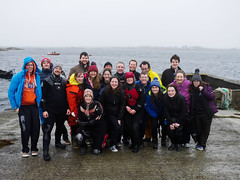This page outlines the course for the Dive Leader grade. This is the third diving grade in the BS-AC grade sequence, and the next after Sports Diver. BS-AC consider the dive leader grade to be equivalent to the PADI Divemaster level.
Definition
A Dive Leader can plan and lead a range of dives including those requiring detailed dive, air and decompression requirements planning. They have the skill and level of knowledge to progressively extend both their own and others experience.
Dive Leaders are competent to carry out dive planning and managing branch dives to locations well known to the Branch or using experienced Charter Boat skippers, or in conditions not normally described as ‘challenging’. (N.B. while dive leaders are permitted to act as marshals under BS-AC rules, this does not apply in DUSAC, where dive marshals must be advanced divers or above).
Dive Leaders can dive to a depth which is initially limited to 35m but which can subsequently be extended progressively to a maximum of 50m. They can dive with any grade of diver including trainee Ocean divers, on dives supervised by a Dive Marshal. Dive Leaders can also progressively expand their own experience when diving with other Dive Leaders.
Training for Dive Leader involves much greater emphasis on gaining broader experience to supplement the ‘formal’ lessons.
The Dive Leader course consists of:
- 12 Classroom lessons – these include the oxygen administration module which can be undertaken at any time after qualifying as an Ocean Diver
- Theory assessment
- 2 Dry practical lessons
- 7 Open water lessons
- 20 dives – (which may include open water lessons) minimum 600 minutes underwater time
Open water diving should encompass experience of at least five of the following:
- planned decompression dive
- navigation dive
- low (1.5-3m) visibility dive
- night dive
- wreck dive
- drift (1-1.5kn) dive
- wall dive
Of the 20 dives, at least six should be from boats, on at least eight the student should act as dive leader, and at least ten dives should be to greater than 25m depth. The student should also act as Dive Marshall on at least two occasions additional to the dry practical lessons.
Syllabus
| Lesson type | Code | Lesson title | Key components |
|---|---|---|---|
| Theory lessons | DT1 | The Role of the Dive Leader | Personal skill development, building experience, site conditions, types of diving, no clear surface diving, drift diving, night diving, deep diving, Risk assessment, known and unknown sites, leading the less experienced |
| DT2 | Basic Life Support | Assessing needs, priorities, clear airway, decision process, Rescue Breathing (RB), Basic Life Support (BLS) | |
| DT3 | Oxygen & Diving Incidents | Oxygen, decompression illness, burst lung, near drowning, shock, Carbon Monoxide poisoning | |
| DT4 | Casualty Assessment | Completing the casualty assessment forms | |
| DT5 | Oxygen Administration Equipment | Oxygen cylinders and regulators, pocket masks, oxygen kits, oxygen precautions | |
| DT6 | Oxygen Administration in Practice | Practicalities, administering oxygen, fluids, evacuation, missed decompression, entonox, safety considerations | |
| DT7 | Use of Oxygen Administration Equipment | Practical use of Oxygen Administration Equipment | |
| DT8 | Dive planning | Dive objectives, site information, charts, electronic position fixing, transits, tides, tide tables, tidal flows, weather | |
| DT9 | Rescue Management 1 | Incident prevention, Incident pit, safety, recovering casualties from the water, first aid, records, emergency services, managing activities, delegation | |
| DT10 | Helicopter Operations | Helicopter evacuations, preparing for a lift | |
| DT11 | Rescue management 2 | Crowd control, media management, incident reporting, legalities | |
| DT12 | Role of the Dive Manager | Role of the dive manager, check lists, diver briefings, marshalling the dive, charter boats, Shot lines, knots, lifting shot lines, Dealing with emergencies | |
| Theory test | Multiple choice review of lecture course | ||
| Open water lessons | DO1 | DSMB Use | Mid-water deployment of Delayed SMB |
| DO2 | Dive Leading Demonstration | Full demonstration of dive leadership by instructor | |
| DO3 | Dive Leader Practice | Practice dive leadership – putting lesson DO2 into practice | |
| DO4 | Shot Recovery | Lifting bags, recovering the shot, mid water deployment of DSMB | |
| DO5 | Rescue Management Scenarios | Practice management of certain incident scenarios | |
| DO6 | Diving & Rescue Skills Review | Mask clearing and AS ascents from 15m | |
| DO7 | Rescue Skills Review | Rescue from 15m, towing with RB for 50m, BLS, Oxygen enriched BLS | |
| Practical lessons | DP1 | Dive Managing 1 | |
| DP2 | Dive Managing 2 | ||
Instructors
All instruction is to be carried out or supervised by a Nationally Qualified Instructor, minimum Open Water Instructor. Other instructor requirements are as follows:
| Grade: | Can instruct: |
|---|---|
| Assistant OWI | Classroom, sheltered water, open water – on site supervision |
| Theory Instructor | Classroom – unsupervised |
| Practical Instructor | Sheltered and open water – unsupervised |
| Open Water Instructor | Classroom, sheltered water, open water – unsupervised |




